Economics - Short run Cost Curves | 11th Economics : Chapter 4 : Cost and Revenue Analysis
Chapter: 11th Economics : Chapter 4 : Cost and Revenue Analysis
Short run Cost Curves
Short
run Cost Curves
1. Total Fixed Cost (TFC)
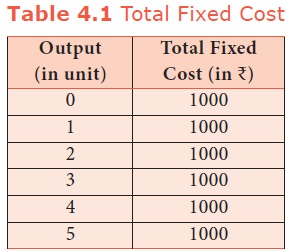
All
payments for the fixed factors of production are known as Total Fixed Cost. A
hypothetical TFC is shown in table 4.1 and diagram 4.1
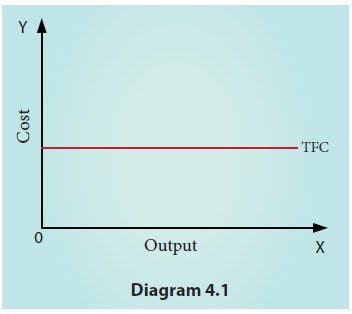
For
instance if TC = Q3 –18Q2 + 91Q +12, the fixed cost here is 12. That means, if
Q is zero, the Total cost will be 12, hence fixed cost.
It could
be observed that TFC does not change with output. Even when the output is zero,
the fixed cost is Rs..1000. TFC is a
horizontal straight line, parallel to X axis.
2. Total Variable Cost (TVC)
All
payments to the variable factors of production is called as Total Variable
Cost. Hypothetical TVC is shown in table-4.2 and Diagram 4.2
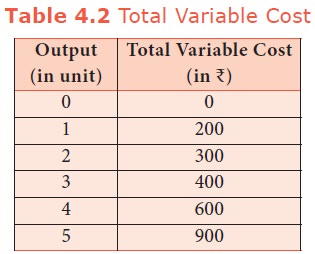
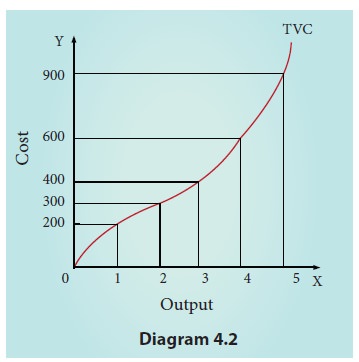
In the
diagram the TVC is zero when nothing is produced. As output increases TVC also
increases. TVC curve slopes upward from left to right. For instance in TC = Q3
– 18Q2 + 91Q +12, variable cost, TVC = Q3 – 18Q2
+ 91Q
3. Total Cost Curves
Total
Cost means the sum total of all payments made in the production. It is also
called as Total Cost of Production.
Total cost is the summation of Total Fixed Cost (TFC) and Total Variable Cost
(TVC). It is written symbolically as
TC = TFC
+ TVC. For example, when the total fixed cost is Rs. 1000 and the total variable cost is Rs. 200 then the Total cost is = Rs. 1200 ( Rs. 1000 + Rs. 200).
If TFC =
12 and
TVC = Q3
– 18Q2 + 91Q
TC = 12 +
Q3 – 18Q2 + 91Q
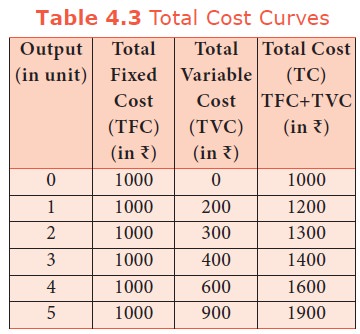
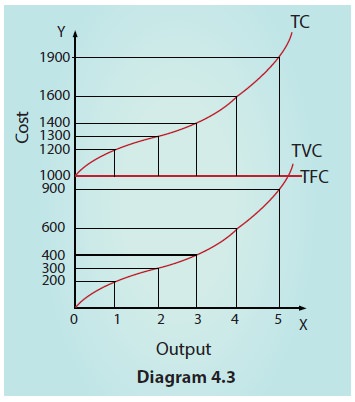
It is to
be noted that
a.
The TC curve is obtained by adding TFC and TVC
curves vertically.
b.
TFC curve remains parallel to x axis, indicating a
straight line.
c.
TVC starts from the origin and moves upwards, as no
variable cost is incurred at zero output.
d.
When TFC and TVC are added, TC starts from TFC and
moves upwards.
e.
TC curve lies above the TVC curve
f.
TVC and TC curves are the same shapes but beginning
point is different.
4. Average Fixed Cost (AFC)
It refers
to the fixed cost per unit of output. It is obtained by dividing the total
fixed cost by the quantity of output. AFC = TFC / Q where, AFC denotes average
fixed cost, TFC denotes total fixed cost and Q denotes quantity of output. For
example, if TFC is 1000 and the quantity of output is 10,
the AFC is Rs. 100, obtained by dividing
Rs. 1000 by 10. TVC is shown in table
4.4 and Diagram 4.4.
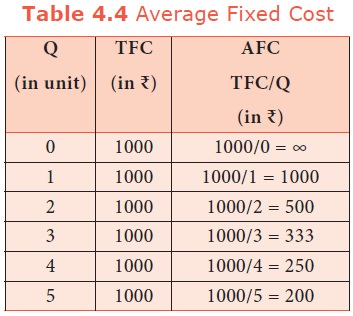
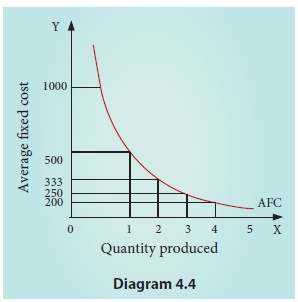
It is to
be noted that
a.
AFC declines as output increases, as fixed cost
remains constant
b.
AFC curve is a downward sloping throughout its
length, never touching X and Y axis. It is asymptotic to both the axes.
c.
The shape of the AFC curve is a rectangular
hyperbola.
5. Average Variable Cost (AVC)
It refers
to the total variable cost per unit of output. It is obtained by dividing total
variable cost (TVC) by the quantity of output (Q). AVC = TVC / Q where, AVC
denotes Average Variable cost, TVC denotes total variable cost and Q denotes
quantity of output. For example, When the TVC is Rs. 300 and the quantity produced is 2, the
AVC is Rs. 150, (AVC = 300/2 = 150) AVC
is shown in table 4.5 and Diagram 4.5. If TVC = Q3 – 18Q2
+ 91Q
AVC = Q2
–18Q + 91

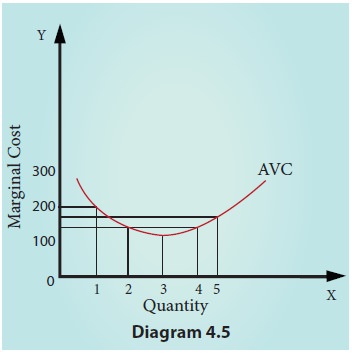
It is to
be noted that
a.
AVC declines initially and then increases with the
increase of output.
b.
AVC declines up to a point and moves upwards
steeply, due to the law of returns.
c.
AVC curve is a U-shaped curve.
6. Average Total Cost (ATC) or Average Cost (AC)
It refers
to the total cost per unit of output.
It can be obtained in two ways.
1. By dividing the firm’s total cost (TC) by the quantity of output (Q). ATC = TC / Q. For example, if TC is Rs. 1600 and quantity of output is Q=4, the Average Total Cost is Rs. 400.
(ATC = 1600/4 =
400) If ATC is Q3 – 18Q2
+ 91Q +12, then AC = Q2 – 18Q +91 12/Q
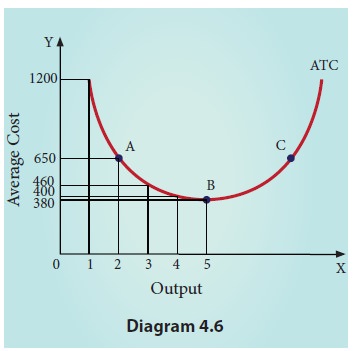
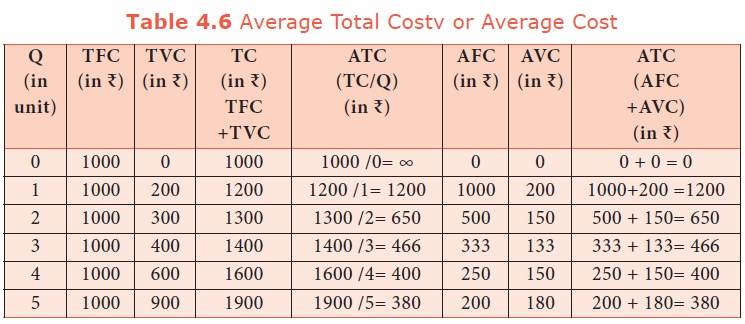
2. ByATC
is derived by adding together Average Fixed Cost (AFC) and Average Variable
Cost (AVC) at each level of output. ATC = AFC + AVC. For example, when
Q= 2, TFC = 1000, TVC=300; AFC=500; AVC=150;ATC=650. ATC or AC is shown
in table 4.6 and Diagram 4.6
It should be noted that
a)
ATC curve is also a ‘U’ shaped curve.
b) Initially
the ATC declines, reaches a minimum when the plant is operated optimally, and
rises beyond the optimum output.
c)
The ‘U’ shape of the AC reflects the law of the
variable proportions.
7. Marginal Cost (MC)
It is the
cost of the last single unit produced. It is defined as the change in total
costs resulting from producing one extra unit of output. In other words, it
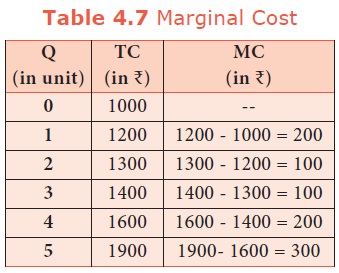
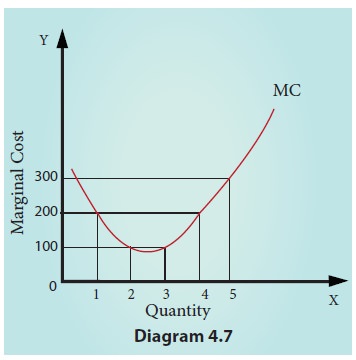
Marginal
cost is important for deciding whether any additional output can be produced or
not. MC = ∆TC / ∆Q where MC denotes Marginal Cost, ∆TC denotes change in total
cost and ∆Q denotes change in total quantity. For example, a firm produces 4
units of output and the Total cost is Rs. 1600. When the firm produces one more unit
(4 +1 = 5 units) of output at the total cost of Rs. 1900, the marginal cost is Rs. 300.
MC = 1900
– 1600 = Rs. 300.
The other
method of estimating MC is :
MC=TCn
–TCn-1 or - TCn+1 –TCn
where,
‘MC’ denotes Marginal Cost, ‘TCn’ denotes Total cost of ‘n’th
item, TCn-1 denotes Total Cost of ‘n-1’ th item, TCn+1
denotes Total Cost of n+1 th item. For example,
when TC4
= Rs.1600, TC(4-1)=Rs.1400 and then MC= Rs.200, (MC=1600-1400)
when TC4
= Rs.1600, TC(4+1)=1900 and then MC= 300.
MC
schedule is shown in Table 4.7 and MC Curve is shown in diagram 4.7. It is to
be noted that
a)
MC falls at first due to more efficient use of
variable factors.
b) MC curve
increases after the lowest point and it slopes upward.
c)
MC cure is a U-shaped curve.
d) The slope
of TC is MC.
If TC = Q3
–18Q2 + 91Q +12
MC = 3Q2
– 36Q +91
8. The relationship between Average Cost and Marginal cost
There is
a unique relationship between the AC and MC curves as shown in diagram 4.8.
1.
When AC is falling, MC lies below AC.
2.
When AC becomes constant, MC also becomes equal to
it.
3.
When AC starts increasing, MC lies above the AC.
4.
MC curve always cuts AC at its minimum point from
below.
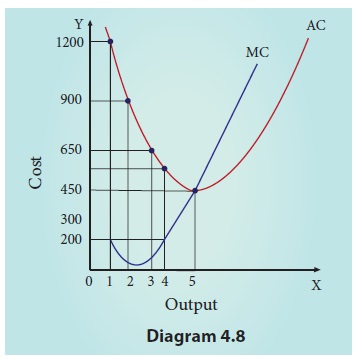
Related Topics